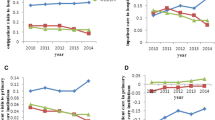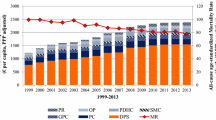Abstract
This study investigates the determinants of regional variations in health care expenditures (HCE) in Switzerland, since there are significant differences between cantons per capita HCE. The empirical analysis contributes to the discussion on the outcome of federalism in the Swiss health care system by improving the understanding of the determinants of the differences in HCE. Our econometric estimations indicate that HCE are significantly related to the density of specialist physicians, density of dispensing doctors, per capita income, proportion of managed care, medical and technological progress and socio-economic factors. Due to the presumptive importance of the organisation of ambulatory care, we suggest policy makers should particularly concentrate on promoting the supply of managed care models in Switzerland. Supporting the development of managed care may help to countervail some of the influences which tend to lead to higher cantonal health expenditures.


Similar content being viewed by others
Notes
The 26 Swiss cantons are Aargau (AG), Appenzell Outer-Rhodes (AR), Appenzell Inner-Rhodes (AI), Basel-Land (BL), Basel-City (BS), Berne (BE), Fribourg (FR), Geneva (GE), Glarus (GL), Grisons (GR), Jura (JU), Lucerne (LU), Neuchatel (NE), Nidwalden (NW), Obwalden (OW), Schaffhausen (SH), Schwyz (SZ), Solothurn (SO), St. Gall (SG), Thurgau (TG), Ticino (TI), Uri (UR), Vaud (VD), Valais (VD), Zug (ZG), Zurich (ZH).
The description of the data set is in Sect. “Data and methods”.
Self-assessed health status "good or very good" in % of population over 15 years of age, 2007: Total Switzerland 86.8%, German-speaking region 87.6%, French-speaking region 85.2% and Italian-speaking region 81.3% [13].
The proportion of the population insured in a managed care model is utilised as a proxy for the positive effect of gatekeeping found by research performed by Gerdtham et al. [19].
Various corrections were performed since part of the data basis was functionally clearly false, due to erroneous data transmission from the cantons. The affected cantons were Appenzell Ausser-Rhodes, Appenzell Inner-Rhodes, Grisons and Jura.
Managed Care models include Health Maintenance Organisations (HMO) and Family doctor models.
Santésuisse is the Association of health insurers in Switzerland.
IHA-IMS Health is one of the largest companies for market intelligence and accountability in global health care.
BAK Basel Economics provides empirical economic research and forecasts for the overall economy.
Since this is the only variable with missing data in 1997, the missing values in 1997 are imputed with the values of 1998 for the analysis.
Since the dummy variable LAT is dichotomous, a log-transformation makes no sense.
Chi-square = 43,9, df = 13, p < 0,000.
A Case-Mix-Index (CMI) variable was estimated in a separate model with the identical variables of the study for the years 2001–2007, since no data was available for prior years. The findings showed the CMI to be not statistically significant. Therefore, we dropped this exogenous variable in favour of a longer time period.
References
OECD/WHO: Schweiz—OECD-Berichte über Gesundheitssysteme. Bundesamt für Gesundheit, Bern (2006)
Swiss Federal Statistical Office, S.F.S.O.: Kosten und Finanzierung des Gesundheitswesens 2007. Bundesamt für Statistik, Sektion Gesundheit, Neuchâtel (2009)
Achtermann, W., Berset, C.: Gesundheitspolitiken in der Schweiz—Potential für eine nationale Gesundheitspolitik: Band 1: Analysen und Perspektiven. Bundesamt für Gesundheit, Bern (2006)
Saltman, R.: Decentralization, re-centralization and future European health policy. Eur. J. Publ. Health 18, 104–106 (2008)
Pedersen, K., Christiansen, T., Bech, M.: The Danish health care system: evolution—not revolution—in a decentralized system. Health Econ. 14, 41–57 (2005)
Mosca, I.: Is decentralisation the real solution? A three country study. Health Pol. 77, 113–120 (2006)
Magnussen, J., Hagen, T., Kaarboe, O.: Centralized or decentralized? A case study of Norwegian hospital reform. Soc. Sci. Med. 64, 2129–2137 (2007)
Wyss, K., Lorenz, N.: Decentralization and central and regional coordination of health services: the case of Switzerland. Int. J. Health Plann. Manag. 15, 103–114 (2000)
Haari, R., Haari-Oberg, I., Schilling, K., Torrisi, M.: Wirkungsanalyse KVG: Kostendifferenzen zwischen den Kantonen. Sozialwissenschaftliche Analyse kantonaler Praktiken. Beiträge zur Sozialen Sicherheit, Forschungsbericht Nr. 15/01. Bundesamt für Sozialversicherung, Bern (2001)
Crivelli, L., Filippini, M., Mosca, I.: Federalism and regional health care expenditures: An empirical analysis for the swiss cantons. Health Econ. 15, 535–541 (2006)
Meyer, K. (ed.): Gesundheit in der Schweiz. Nationaler Gesundheitsbericht 2008. Buchreihe des Schweizerischen Gesundheitsobservatoriums. Verlag Hans Huber, Bern (2008)
OECD: OECD Health Data 2009, November 2009. OECD. http://www.oecd.org/document/16/0,3343,en_2649_34631_2085200_1_1_1_1,00.html (2009). Accessed 17 February 2010
Swiss Federal Statistical Office SFSO: Gesundheitszustand—Daten, Indikatoren. Selbst wahrgenommener Gesundheitszustand nach Geschlecht, Alter, Sprachgebiet und Bildungsniveau, 1992–2007. http://www.bfs.admin.ch/bfs/portal/de/index/themen/14/02/01/key/01.html (2009). Accessed 17 Nov 2010
Gerdtham, U.G., Jönsson, B.: International comparisons of health expenditure: Theory, data and econometric analysis. In: Culyer, A.J., Newhouse, J.P. (eds.) Handbook of Health Economics, pp. 11–53. Elsevier Science, North Holland (2000)
Newhouse, J.P.: Medical care expenditure: a cross-national survey. J. Hum. Resour. 12, 115 (1977)
Leu, R.E.: The public-private mix and international health care costs. In: Culyer, A.J., Jonsson, B. (eds.) Public and Private Health Services, pp. 41–63. Basil Blackwell, Oxford (1986)
Gerdtham, U.G., Sogaard, F., Andersson, F., Jönsson, B.: An econometric analysis of health care expenditure: A cross-section study of the OECD countries. J. Health Econ. 11, 63–84 (1992)
Hitris, T., Posnett, J.: The determinants and effects of health expenditure in developed countries. J. Health Econ. 11(2), 173–181 (1992)
Gerdtham, U.G., Jönsson, B., MacFarlan, M., Oxley, H.: The determinants of health expenditure in the OECD countries. A pooled data analysis. In: Zweifel, P. (ed.) Health, The Medical Profession and Regulation, pp. 113–134. Kluwer, Dordrecht (1998)
Barros, P.P.: The black-box of health care expenditure growth determinants. Health Econ. 7, 533–544 (1998)
Camenzind, P.: Erklärungsansätze regionaler Kostenunterschiede im Gesundheitswesen: Analyse der internationalen gesundheitsökonomischen und gesundheitsstatistischen Literatur–mit besonderem Fokus auf die Schweiz; Arbeitsdokument 30. Schweizerisches Gesundheitsobservatorium Obsan, Neuchâtel (2008)
Di Matteo, L., Di Matteo, R.: Evidence on determinants of Canadian provincial Government health expenditures: 1965–1991. J. Health Econ. 17, 211–228 (1998)
Ariste, R, Carr, J.: New Considerations on the Empirical Analysis of Health Expenditures in Canada: 1966-1998, Working document 02-06. Health Canada. http://www.hc-sc.gc.ca/sr-sr/pubs/hpr-rpms/wp-dt/2003-0206-expend-depens/intro-eng.php (2003). Accessed 5 December 2008
Vatter, A., Rüefli, C.: Do Political Factors Matter for Health Care Expenditure? A Comparative Study of Swiss Cantons. J. Publ. Pol. 23, 301–323 (2003)
Sturny, I.: 5-Jahres-Vergleich 1999–2003 der Kosten der stationären und ambulanten Gesundheitsversorgung in der Schweiz. Analyse der Krankenversicherer OKP mit dem Datenpool santésuisse. Arbeitdokument 10. Schweizerisches Gesundheitsobservatorium, Neuchâtel (2004)
Schleiniger, R., Slembeck, T., Blöchliger, J.: Bestimmung und Erklärung der kantonale Mengenindizes der OKP-Leistungen. Zürcher Hochschule für angewandte Wissenschaften, Zentrum für Wirtschaftspolitik. http://pd.zhaw.ch/hop/1486960037.pdf (2007). Accessed 3 December 2008
Crivelli, L., Filippini, M., Mantegazzini-Antonioli, B., Pallotti, F.: I costi dell’assicurazione mallattia nel cantone del Ticino—Rapporto finale, Università della Svizzera italiana, Lugano. http://www.common.unisi.ch/pdf_pub3449 (2008). Accessed 5 December 2008
Straub, M., Hartwig, J.: Herbstprognose der schweizerischen Gesundheitsausgaben 2008–2011. ETH Zürich, KOF Konjunkturforschungsstelle, Zürich (2009)
Taskin, A., Bisig, B.: Nationalität und Inanspruchnahme von Gesundheitsleistungen. In: Bisig, B., Gutzwiller, F. (eds.) Gesundheitswesen Schweiz: Gibt es Unter- oder Überversorgung? Band 1: Gesamtübersicht, pp. 83–118. Verlag Rüegger, Zürich/Chur (2004)
Rüefli, C., Vatter, A.: Wirkungsanalyse KVG: Kostendifferenzen im Gesundheitswesen zwischen den Kantonen. Statistische Analyse kantonaler Indikatoren. Beiträge zur Sozialen Sicherheit, Forschungsbericht Nr. 14/01. Bundesamt für Sozialversicherung, Bern (2001)
Breyer, F., Zweifel, P.: Gesundheitsökonomie. Springer, Berlin (1997)
Lehmann, H.: Managed Care—Kosten senken mit alternativen Krankenversicherungsformen; Eine empirische Analyse anhand Schweizer Krankenversicherungsdaten. Verlag Rüegger, Zürich/Chur (2003)
Prognos, A.G., Baur, R., Hunger, W., Kämpf, K., Stock, J.: Evaluation neuer Formen der Krankenversicherung. Beiträge zur Sozialen Sicherheit. Bundesamt für Sozialversicherung, Bern (1998)
Beck, K., Käser, U., Trottmann, M., Von Rotz, S.: Effizienzsteigerung dank Managed Care. Datamaster 5, 15–21 (2009)
Beck, K., Kunze, U., Oggier, W.: Selbstdispensation: Kosten treibender oder Kosten dämpfender Faktor? Manag. Care 6, 5–8 (2004)
Federal Office of Public Health F.O.P.H.: Statistik der obligatorischen Krankenversicherung 2007. Bundesamt für Gesundheit, Bern (2008)
Werblow, A., Felder, S., Zweifel, P.: Population Ageing and Health Care Expenditure: A School of ‘Red Herrings’? Health Econ. 16, 1109–1126 (2007)
Felder, S., Meier, M., Schmitt, H.: Health care expenditure in the last months of life. J. Health Econ. 19, 679–695 (2000)
Swiss Government: Botschaft zum Bundesgesetz über die Neuordnung der Pflegefinanzierung. http://www.admin.ch/ch/d/ff/2005/2033.pdf (2005). Accessed 15 April 2006
Bodenheimer, T.: Coordinating care—a perilous journey through the health care system. New Engl. J. Med. 358(10), 1064–1071 (2008)
Author information
Authors and Affiliations
Corresponding author
Appendix
Rights and permissions
About this article
Cite this article
Reich, O., Weins, C., Schusterschitz, C. et al. Exploring the disparities of regional health care expenditures in Switzerland: some empirical evidence. Eur J Health Econ 13, 193–202 (2012). https://doi.org/10.1007/s10198-011-0299-x
Received:
Accepted:
Published:
Issue Date:
DOI: https://doi.org/10.1007/s10198-011-0299-x




